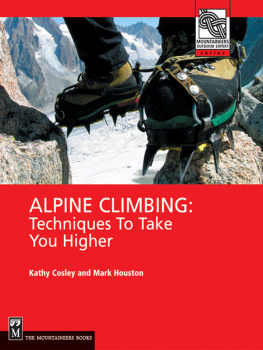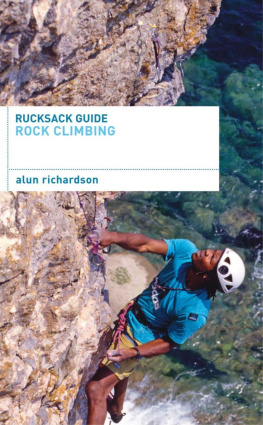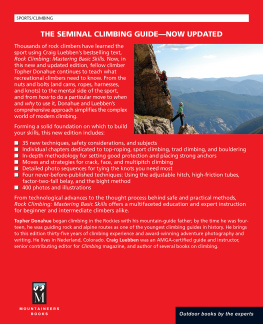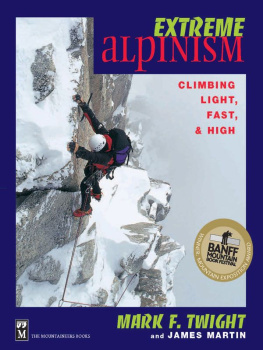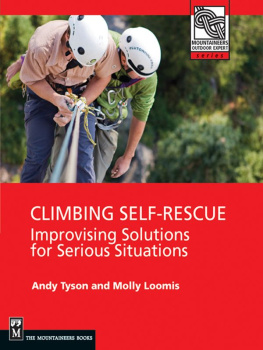Acknowledgments
We would like first and foremost to thank Peter Lewis, without whom this book would never have come to be. We also are deeply grateful for the wise counsel, criticism, and careful reading of a handful of generous friends: Christopher Kulp, Leigh McGuigan, and Margaret Willson. We owe a great debt as well to Erin Moore and Kris Fulsaas for their tremendous help and clear guidance.
Special thanks and credit (or blame) are due to Ira Kalet and Bruce Sherman, for providing our first introduction to mountaineering. Our many other teachers are too numerous to mention individually here, but we sincerely thank and acknowledge all the many friends and climbing partners who have taught us over the years how to climb and how to live.
Most of all we thank our parents, who set our feet upon the path and encouraged us every step of the way.
Appendix A. Guides Associations
The International Federation of Mountain Guides Associations (IFMGA, also known as UIAGM and IVBV) is an international organization containing the national guides associations of more than twenty countries worldwide. The IFMGA sets standards for the training and certification of mountain guides. Member countries' national training and certification programs must meet the international standard.
In many IFMGA member countries, only IFMGA certified guides may legally conduct professional mountain guiding. This is not the case in the United States. The American Mountain Guides Association is a member of the IFMGA and provides guides training and certification programs at the international standard. However, only a minority of American guides have participated in these programs as of the time of this writing. Most of these guides are certified in one or more disciplines: alpine mountaineering, rock climbing, or ski mountaineering. Certification in each discipline entails a series of courses followed by an in-the-field examination lasting several days. Only guides certified in all three disciplines are IFMGA certified. See the AMGA website listed below for an explanation of its training and certification programs and for a listing of American certified guides.
Listed below are the guides associations of the main Alpine countries (France, Italy, and Switzerland) and those of the English-speaking member nations (Canada, Great Britain, New Zealand, and the United States). Other member associations are Aosta, Austria, Germany, Japan, Norway, Peru, Poland, Slovakia, Slovenia, South Tyrol, Spain, and Sweden. For information about these countries, contact the IFMGA Secretary:
Armin Oehrli, Secretary
IFMGA/UIAGM/IVBV
Phone: +41-33-744-54-10
Email:
www.ivbv.info
NATIONAL GUIDES ASSOCIATIONS
CANADA
Association of Canadian Mountain Guides Box 9341
Canmore, Alberta T1W 2V1 Canada
Appendix A. Guides Associations
Phone: 403-678-2885, Fax 403-609-0070
Email:
www.acmg.ca
FRANCE
Syndicat National des Guides de Montagne
210, rue Franois Guise
F-73000 Chambry France
Phone: +33 (0) 4-79-68-51-05
Fax: +33 (0) 4-79-68-65-90
Email:
www.sngm.com
GREAT BRITAIN
British Association of Mountain Guides
Siabod Cottage, Capel Curig
Conway, North Wales LL24 0ET
United Kingdom
Phone: +44 (0) 1690-720-386
Fax: +44 (0) 1690-720-248
Email:
www.bmg.org.uk
ITALY
Collegio Nazionale Guide Alpine Italiane
Via Petrella 19
20124 Milano
Italy
NATIONAL GUIDES ASSOCIATIONS
Phone: +39-02-2941-4211
Fax: +39-02-2941-7650
Email:
www.guidealpine.it
NEW ZEALAND
New Zealand Mountain Guides
Association Inc.
Executive officer, P.O. Box 10
Aoraki, Mount Cook 8770
New Zealand
Phone and fax: +64-3-434-2355
Email:
www.nzmga.co.nz
SWITZERLAND
Schweizer Bergfhrerverband
Geschftsstelle Hadlaubstrasse 49
CH-8006 Zrich
Switzerland
Phone: +41-1-36053-66
Fax: +41-1-360-53-69
Email:
www.4000plus.ch
UNITED STATES
American Mountain Guides Association
PO Box 1739
Boulder, CO 80302
USA
Phone: 303-271-0984
Fax: 303-271-1377
Email:
www.amga.com
Appendix B. Rescue
We hope you will never need to rescue or be rescued. In our more than 25 years of climbing and almost as many years of guiding, we have had little need, thankfully, to execute or call for rescues, even for other parties. Still, it is important to be prepared and to have a clear idea of your prioritiesjust in case.
Most rescues are trivial affairs. Someone sprains an ankle and has to be carried out piggyback; someone strains his or her back and you have to carry his or her pack. In a rare instance, you may be called upon to take part in a more complex rescue scenario. Whether you must take charge or merely help out, the following should help you make the best use of available resources while avoiding added risk.
INITIAL STEPS
KEEP CALM
Whenever you approach an accident or injury, your first priority is to maintain a calm state of mind in which you can weigh options and risks while keeping the big picture in mind. Nothing is so urgent that you can't take a moment to breathe and collect yourself before acting.
SAFEGUARD YOUR PARTY
Your primary duty is to safeguard yourself and those not yet injured. The best of intentions don't justify risking other lives, including your own, for the sake of someone who is already hurt. Something bad has happened to that person; don't make it worse.
Look first for signs of ongoing hazards before you move in to check out the accident and injuries. If rockfall, avalanche, or other hazards threaten further injury to either the victim or rescuers, you may need to seriously consider the wisdom of attempting a rescue at all. If you do proceed, you may have no choice but to move the victim to a safer place, no matter what injuries he or she might have sustained, and to do so as quickly as possible. If the hazard no longer exists, take your time and do not move the victim unnecessarily.
Rescue situations are often inherently stressful and confusing for everyone involved. People tend to neglect their own safety as they focus on the injury or accident. Careless mistakes are more likely than usual. Protect yourself and others by expecting this and taking preventive measures. When on exposed terrain, even if it is easy ground or a large ledge, make sure that everyone is anchored in or otherwise secured.
DECIDE WHETHER TO SELF-RESCUE OR SUMMON OUTSIDE HELP
A helicopter rescue or competent evacuation by a search and rescue teamif readily available can save lives and improve outcomes. However, in many cases, such outside help will be slow to reach you or less competent than you are. Depending on the degree of the victim's injury, you may be able to evacuate the injured person more quickly or effectively without outside help.
In deciding whether or not to self-evacuate, compare the quality and timeliness of outside help with your own resources. Consider also the impact on the injury and the safety of the party.
SUMMONING OUTSIDE HELP
If you decide to seek outside help, there may be various ways to get it.
Send a Note Out
You can send one or two of your group out with a note and instructions for a rescue party (see Convey Crucial Information, below). Do not rush this effort: before the messengers leave, make sure they know exactly what they must accomplish and exactly how they will accomplish it. They may need to take the map; do you have another? If not, note down all necessary information about your location before you relinquish any maps.
Use a Phone or Radio
Next page
